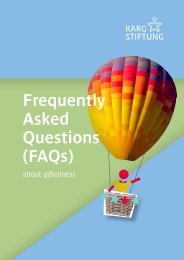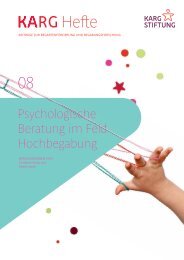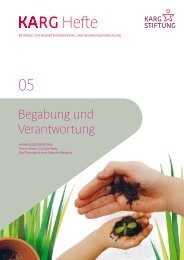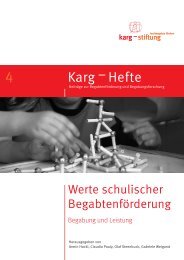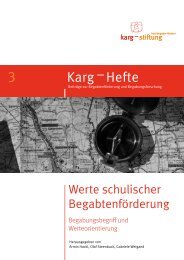Karg-Heft Nr. 7: Hochbegabten- förderung in der Sekundarstufe
Ergebnisse der PULSS-Studie zur Untersuchung der gymnasialen Begabtenklassen in Bayern und Baden-Württemberg
Ergebnisse der PULSS-Studie zur Untersuchung der gymnasialen Begabtenklassen in Bayern und Baden-Württemberg
Erfolgreiche ePaper selbst erstellen
Machen Sie aus Ihren PDF Publikationen ein blätterbares Flipbook mit unserer einzigartigen Google optimierten e-Paper Software.
64<br />
LUPKOWSKI-SHOPLIK, A./BENBOW, C. P./ASSOULINE,<br />
S. G./BRODY, L. E. (2003): Talent searches: Meet<strong>in</strong>g the needs of<br />
academically talented youth. In: Colangelo, N./Davis, G. A. (Hrsg.):<br />
Handbook of Gifted Education. 3. Auflage. Boston, MA: Allyn & Bacon,<br />
S. 204–218.<br />
MARSH, H. W./SEATON, M./TRAUTWEIN, U./LÜDTKE, O./HAU,<br />
K. T./O’MARA, A. J./CRAVEN, R. G. (2008): The Big-Fish-Little-<br />
Pond-Effect stands up to critical scrut<strong>in</strong>y: Implications for theory,<br />
methodology, and future research. In: Educational Psychology Review<br />
20, S. 319–350.<br />
MEIER, E./VOGL, K./PRECKEL, F. (2014): Motivational characteristics<br />
of students <strong>in</strong> gifted classes: The pivotal role of Need for Cognition.<br />
In: Learn<strong>in</strong>g and Individual Differences.<br />
MÖLLER, J./TRAUTWEIN, U. (2009): Selbstkonzept. In:<br />
Wild, E./Möller, J. (Hrsg.): Pädagogische Psychologie. Berl<strong>in</strong>: Spr<strong>in</strong>ger,<br />
S. 179–204.<br />
OSWALD, H./UHLENDORFF, H. (2008): Die Gleichaltrigen [Peers].<br />
In: Silbereisen, R./Hasselhorn, M. (Hrsg.): Entwicklungspsychologie<br />
des Jugendalters (Enzyklopädie <strong>der</strong> Psychologie, Serie Entwicklungspsychologie,<br />
Bd. 5). Gött<strong>in</strong>gen: Hogrefe, S. 189–228.<br />
PATRICK, H./ANDERMAN, L. H./RYAN, A. M. (2002): Social motivation<br />
and the classroom social environment. In: Midgley, C. (Hrsg.):<br />
Goals, goal structures, and patterns of adaptive learn<strong>in</strong>g. Mahwah, NJ:<br />
Erlbaum, S. 85–108.<br />
PRECKEL, F./NIEPEL, C./SCHNEIDER, M./BRUNNER, M. (2013):<br />
Self-concept <strong>in</strong> adolescence: A longitud<strong>in</strong>al study on reciprocal effects<br />
of self-perceptions <strong>in</strong> academic and social doma<strong>in</strong>s. In: Journal of<br />
Adolescence 36, S. 1165–1175.<br />
PRECKEL, F./VOCK, M. (2013): Hochbegabung. E<strong>in</strong> Lehrbuch zu<br />
Grundlagen, Diagnostik und För<strong>der</strong>möglichkeiten. Gött<strong>in</strong>gen: Hogrefe.<br />
REIS, S. M./MCCOACH, D. B. (2000): The un<strong>der</strong>achievement of<br />
gifted students: What do we know and where do we go? In: Gifted<br />
Child Quarterly 44, H. 3, S. 152–170.<br />
SCHIEFELE, U./KRAPP, A./SCHREYER, I. (1993): Metaanalyse des<br />
Zusammenhangs von Interesse und schulischer Leistung. In:<br />
Zeitschrift für Entwicklungspsychologie und Pädagogische Psychologie<br />
25, S. 120–148.<br />
SEATON, M./MARSH, H. W./CRAVEN, R. G. (2009): Earn<strong>in</strong>g its place<br />
as a pan-human theory: Universality of the big-fish-little-pond effect<br />
across 41 culturally and economically diverse countries. In: Journal of<br />
Educational Psychology 101, S. 404–419.<br />
SLAVIN, R. E. (1987): Ability group<strong>in</strong>g and student achievement <strong>in</strong><br />
elementary schools: A best-evidence synthesis. In: Review of Educational<br />
Research 57, S. 292–336.<br />
SONTAG, C./STÖGER, H. (2010): Selbstreguliertes Lernen und<br />
Hochbegabung. In: Journal für Begabten<strong>för<strong>der</strong>ung</strong> 10, S. 6–23.<br />
TRAUTWEIN, U./LÜDTKE, O./SCHNYDER, I./NIGGLI, A. (2006):<br />
Predict<strong>in</strong>g homework effort: Support for a doma<strong>in</strong>-specific, multilevel<br />
homework model. In: Journal of Educational Psychology 98,<br />
S. 438–456.<br />
WIGFIELD, A./ECCLES, J. S./SCHIEFELE, U./ROESER, R. (2008):<br />
Development of achievement motivation. In: Damon, W./Lerner,<br />
R. M. (Hrsg.): Child and adolescent development: An advanced course.<br />
New York: Wiley, S. 406–434.<br />
ZEIDNER, M./SCHLEYER, E. J. (1999A): Evaluat<strong>in</strong>g the effects of<br />
full-time vs. part-time educational programs for the gifted: Affective<br />
outcomes and policy consi<strong>der</strong>ations. In: Evaluation and Program<br />
Plann<strong>in</strong>g 22, S. 413–427.<br />
ZEIDNER, M./SCHLEYER, E. J. (1999B): The effects of educational<br />
context on <strong>in</strong>dividual difference variables, self-perceptions of<br />
giftedness, and school attitudes <strong>in</strong> gifted adolescents. In: Journal of<br />
Youth and Adolescence 28, S. 687–703.<br />
ZIEGLER, A. (2009): Selbstreguliertes Lernen Hochbegabter. In:<br />
L<strong>in</strong>-Klitz<strong>in</strong>g, S./Di Fuccia, D./Müller-Frerich, G. (Hrsg.): Begabte <strong>in</strong> <strong>der</strong><br />
Schule – För<strong>der</strong>n und For<strong>der</strong>n. Beiträge aus neurobiologischer,<br />
pädagogischer und psychologischer Sicht. Bad Heilbrunn: Kl<strong>in</strong>khardt,<br />
S. 81–98.<br />
ZIMMERMAN, B. J. (2000): Atta<strong>in</strong><strong>in</strong>g self-regulation: A social<br />
cognitive perspective. In: Boekaerts, M./P<strong>in</strong>trich, P. R./Zei<strong>der</strong>, M.<br />
(Hrsg.): Handbook of self-regulation. San Diego, CA: Elsevier<br />
Academic Press, S. 13–39.



